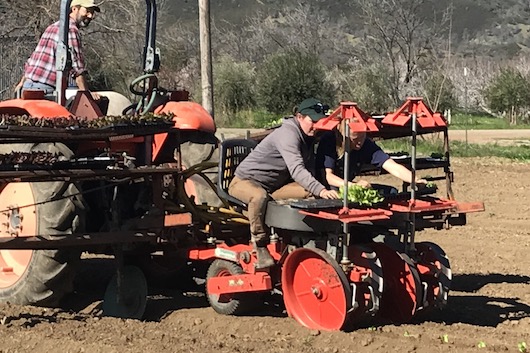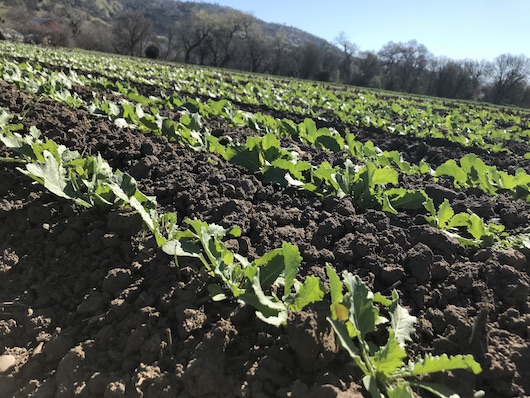
Transplanting lettuce in February —
Being and living the change that one wants to see in the world is our calling as we seek to develop wisdom and compassion. Right relationship, right livelihood, right action, right concentration, right mindfulness, right thought and right speech are practices and markers for our journey. These are part of Buddhist teaching but are also part of the whole of any spiritual practice. Observing and listening to the quiet and beauty of the natural world surrounding us gets us closer, helping us while demonstrating the profound beauty of the world we inhabit.
The beauty of our little valley was on full display this past weekend. The air was redolent with the sweetness of almond blossom fragrance – subtle and soft like the delicate flowers themselves that grace orchards and roadside. The aroma is carried on soft breezes, in morning fog or as a soft touch of awakening – fragrant infusion of awareness with almond perfume.
The green hills and fields are alive with rich waxy grasses, curling tentacles of vetches, carpets of clover and the small flowers of shepherds purse, groundsel, plantain, mustards, and henbit. We have a wave of winter birdlife finding a home here during the winter. There are hawks building nests and raising fledges, and an occasional golden eagle attracted to the pastured chickens is looking for an easy snack. Robins, towhees, flights of sparrows and the regular morning doves enliven the sky and fill both bare and blooming trees with song. It is a remarkable and beautiful time here.
There were thousands of visitors celebrating our Almond Festival this weekend. The Full Belly crew cranked out some 450 pizzas from two pizza ovens in five hours, all cooked with tasty organic ingredients. Dru was pulling pork for sliders along with a crew of bean cookers and slaw slingers. The Grange had homemade ice cream and sweet treats along with local crafters selling their wares. Visitors stopped, shared stories and food and helped to raise funds to keep Halls open in support of their country cousins. It was a remarkable community effort here as part of a historical continuum spanning 106 years.
Observing a fertile springtime unfold around us is different each year. This February has been one of the driest on record if we finish the week without rain. The dry is quite a contrast to last year’s rainy, tumultuous spring. We have had a chance to plant our potatoes and spring greens, transplant lettuces and fennels, cultivate and control weed in soils that seemed a just-right moisture. Cover crops of grains, legumes, tillage radish and weeds are blanketing fields and providing a mantle of green to protect and feed soil life. It is a natural symphony, for us as we balance opportunity with patience and observation.
Even our relationship with ‘weeds’ can change with the season. As the groundsel and henbit bloom pink and purple and the yellow sprays of mustards splash themselves in the fields and the slender stalks of shepherds purse show their delicate white flowers, we need to practice restraint and observe their work. I am beginning to think of these weeds as both soil remediators and indicators. They are working to cover up soil that is exposed to the sun, pulling up nutrients, or sending roots deep. Most seem hardy and free of insect and disease. These plants are well adapted, usually have medicinal properties and are generally free from the insect pressure that can exist on cultivated crops. Our task, instead of eliminating them completely, may be more one of managing their lifecycle in a growing system.

Baby Greens seeded on January 13
The opportunity to learn from nature is afforded by giving systems space to express diverse character. When life and diversity are allowed a space on a farm and not tightly controlled, new things can be learned through observation. One can learn from plants, flowers, insects, roots and soil. If soil is laid bare or tilled for the look of ‘good management’ and clean soil, the potential to see and learn is forsaken. Without flowers and diverse understory there is no pollen and nectar for beneficial insects and pollinators like bees, lacewings or ladybugs. No insects mean fewer meals for birds and thus fewer songs in the morning. For farmers who rent farmland, it is often the landlord who determines the look of their land. Increasingly bare, herbicided field edges are seen as a sign of a good land manager. Tight control leaves little space for observation or delight in the life that shows up.
A pathway forward is to support the principles of diversity in a farmscape. We can re-create investment in fostering more life by investing in the systems that celebrate that relationship and supporting the pathway of right relationship and right action. The ideas of agro-ecology and farms as crucibles of life require investment and support in the marketplace and in the minds of policymakers. We appreciate your support of our farming efforts. We are still learning and sharing. That is our work and journey.
–Paul Muller, co-owner
